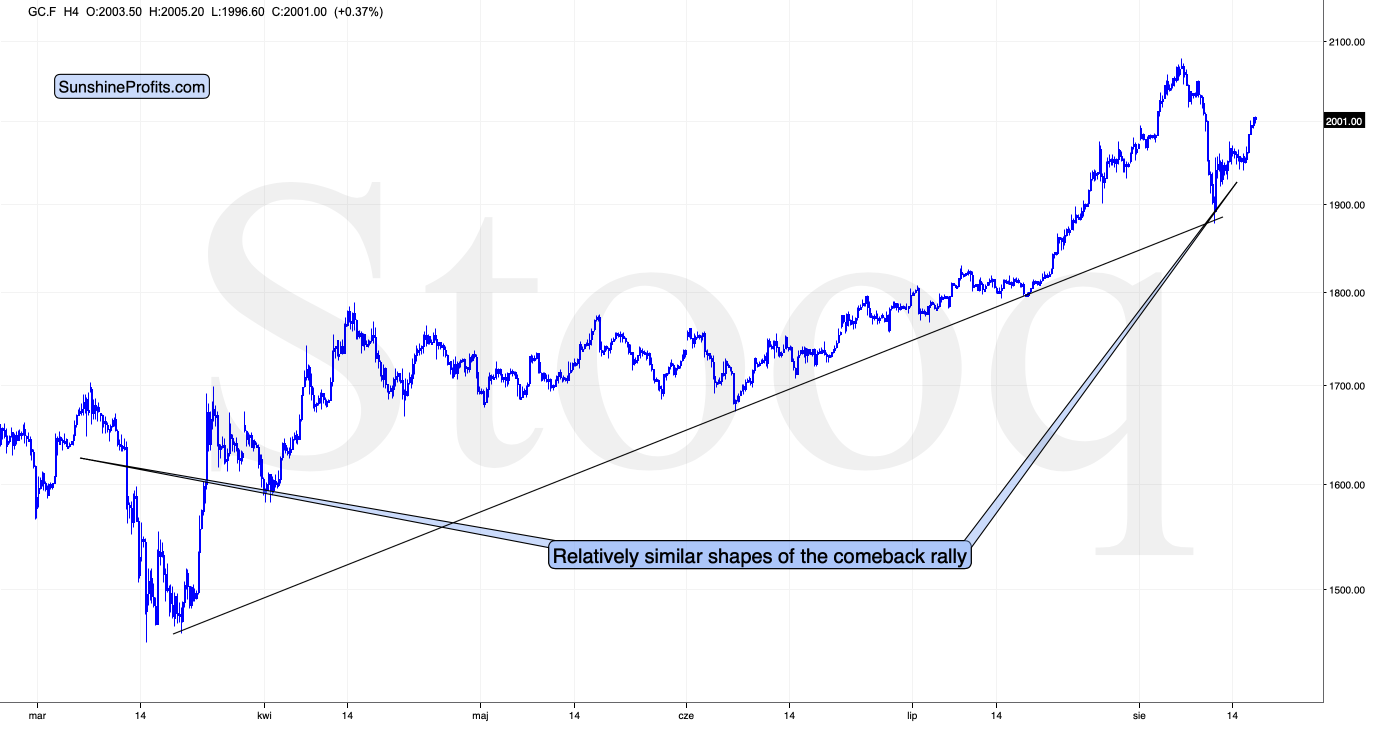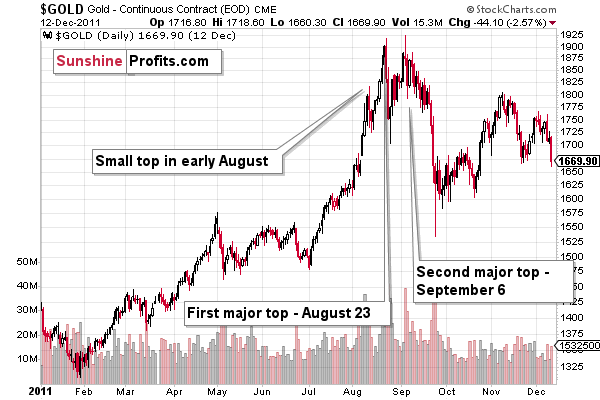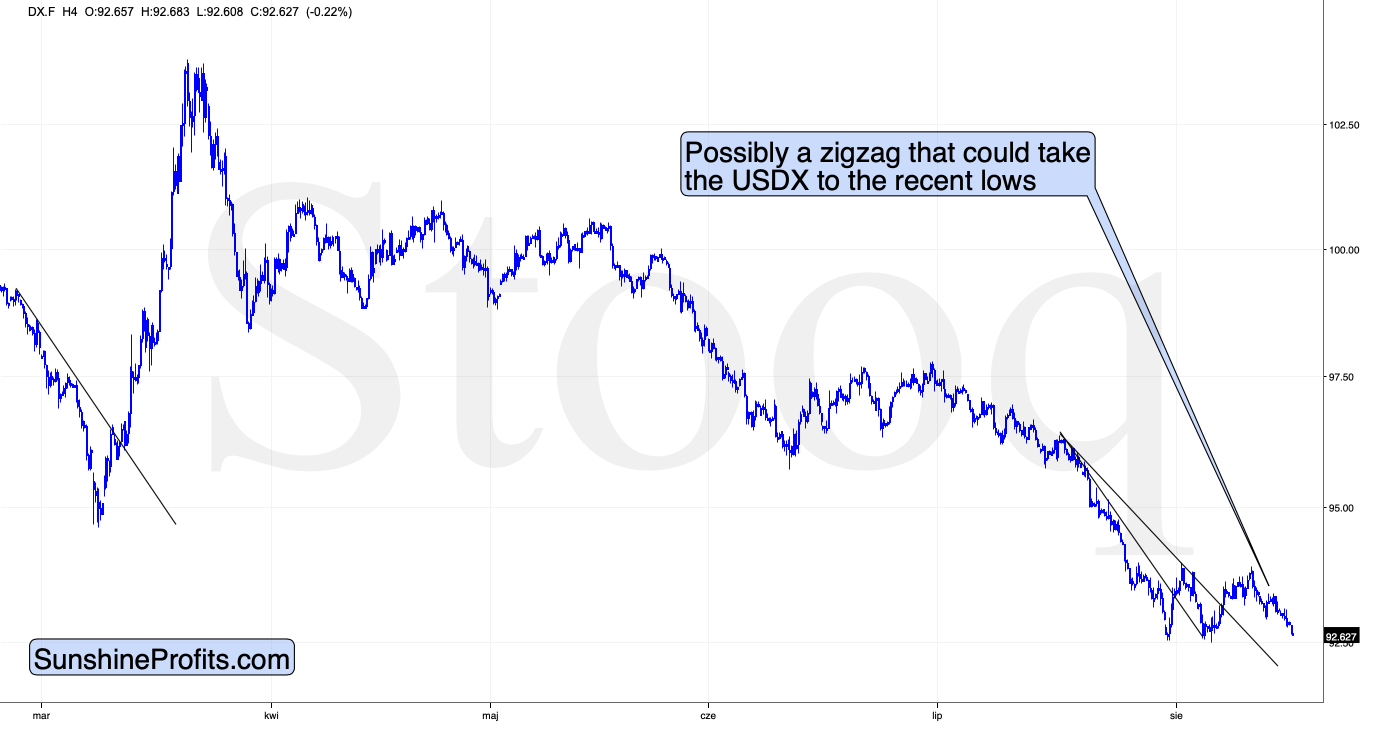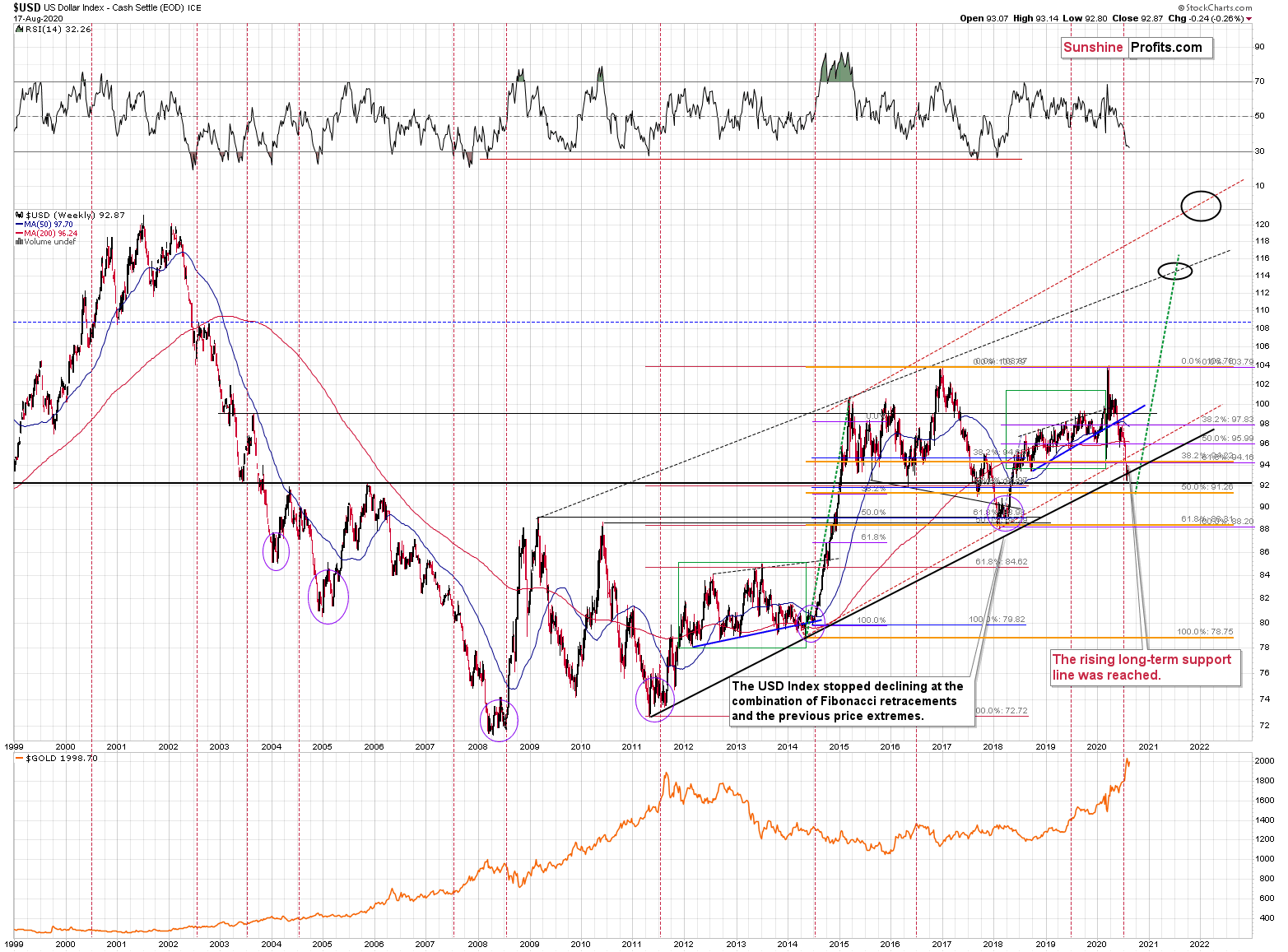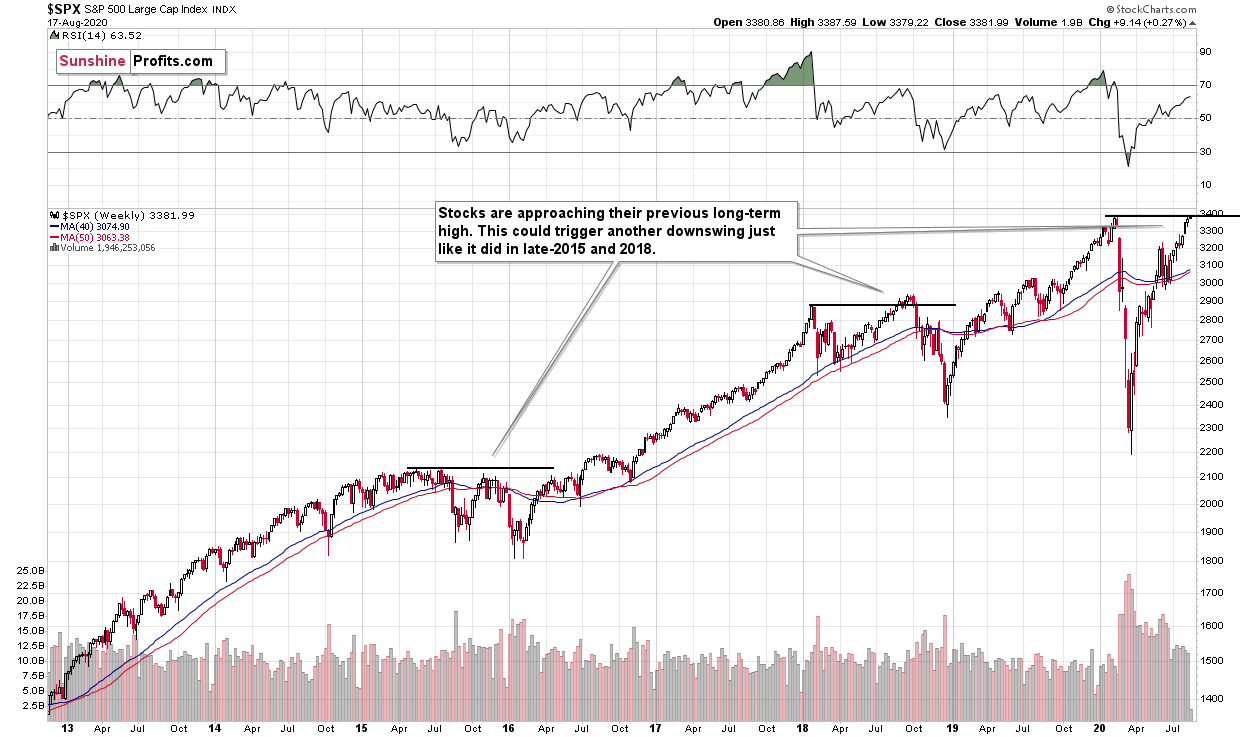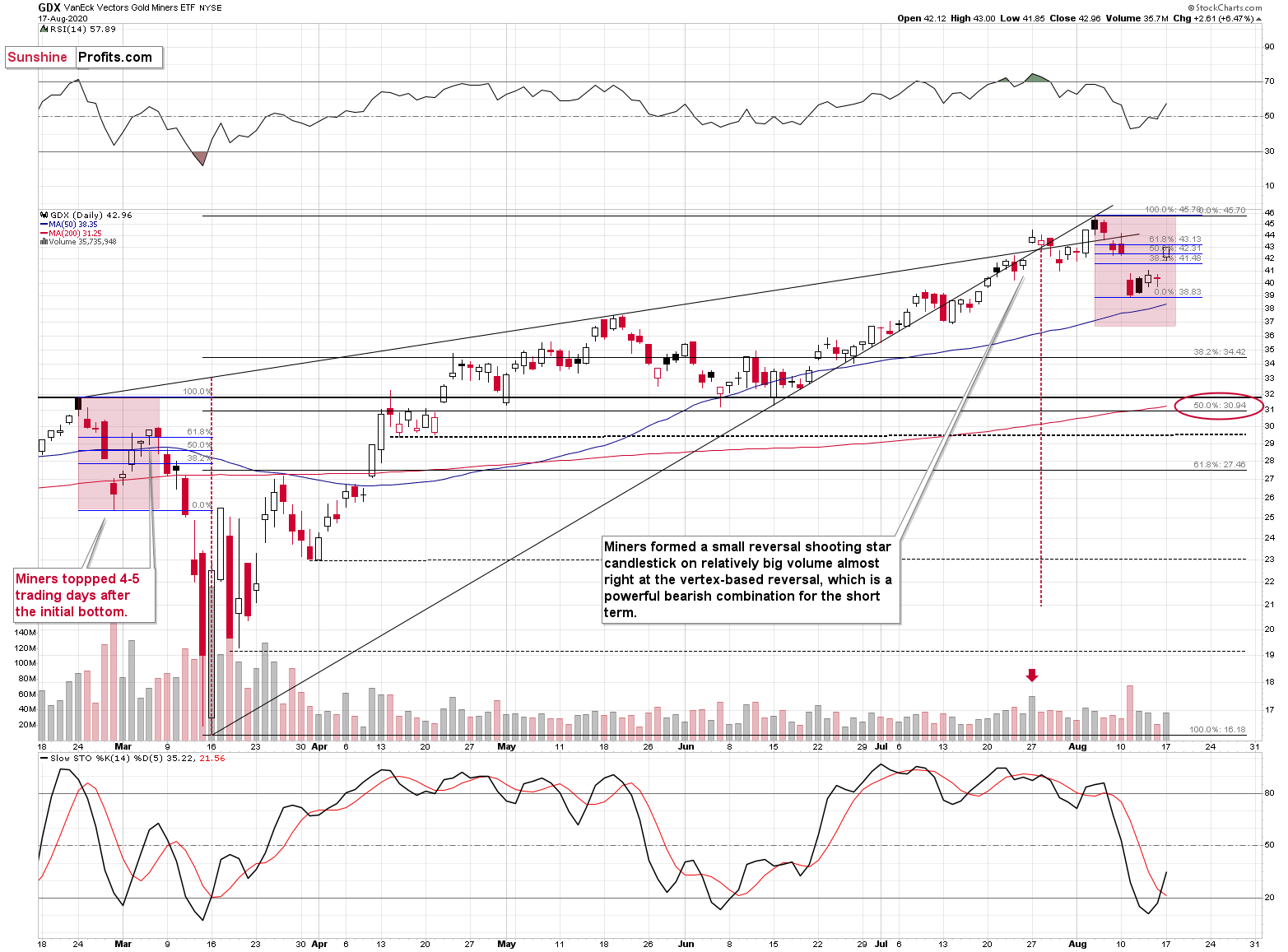Briefly: in our opinion, full (300% of the regular position size) speculative short positions in mining stocks are justified from the risk/reward point of view at the moment of publishing this Alert.
In yesterday's Alert, we wrote that gold was likely to move higher - at least to $2,000, while the USD Index continued to form its broad bottom, while the GDX ETF was likely to move to about $43.
That's exactly what happened yesterday and what continues in today's pre-market trading.
Gold is trading above $2,000 while the similarity to the early-March rally remains intact. This means that gold is likely to move even higher before plunging. In fact, we still think that a move a bit above the previous high, and then a profound invalidation are likely.
After all, that's what the similarities to both: March top, and the 2011 top suggest.
On the above chart you can also see that the pace at which gold corrected upward before the final (second) top, was slightly smaller than the pace at which gold declined from the first top. Consequently, seeing this kind of action right now is not a reason to be concerned. Even if gold moves slightly above the previous 2020 high this week, the short-term outlook would likely remain bearish.
The next support - and target - is at $1,700, which is where - approximately - gold topped and bottomed multiple times earlier this year.
Please note that in its moves, gold is currently super-sensitive to what's happening in the USD Index. This month's $200+ decline and the subsequent rebound in gold were triggered by less than a 1.5 index point rally and then a decline in the USDX. This means that quite likely even small moves in the USDX in the next several hours - days could be enough to trigger a big rally and an even bigger decline in gold.
This also means, that once the USD Index rallies in a more profound way, gold would be likely to truly plunge.
The U.S. currency is finally after a decisive short-term breakout. In fact, it's already after two short-term breakouts. Looking at the short-term picture only, the USD's sideways trading could be both: a triple-bottom pattern, or a flag consolidation pattern. The former would be bullish, and the latter would be bearish.
Based on the long-term chart, the bullish interpretation is stronger. The previous attempts to break below the medium-term, rising, black support line were invalidated and we think that the current attempt will be invalidated as well.
It might be the case that the bottom in the USD Index and a top in gold would correspond to a top in the general stock market.
The S&P 500 is approaching its previous 2020 high and it's very, very close. Given the economic background, I find this performance unfounded. But the markets can stick to a certain emotional trend for longer than many investors can remain logical, which would fit the above picture.
Back in 2015 stocks topped below their previous highs, and in 2018 they topped a bit above them, so the proximity to the previous is far from being a precise sell signal. It does indicate, that the stock market is likely vulnerable to sell signals coming from other markets and that this emotional rally could end sooner rather than later.
Do you remember what happened in February when the S&P 500 lost its upward momentum? They plunged, and that was when tops in mining stocks and silver formed. Gold made another attempt to move higher but ultimately declined profoundly in the following days.
And what was even more profound, was the decline in the mining stocks.
Shortly after gold topped in 2011, miners recovered and re-tested the previous high once again, so one might think that something similar is likely also this time. We don't think so. The likely reason behind miner's brief comeback in 2011 was a move higher in the stock market. After stocks move a bit higher from here and then invalidate the breakout above the previous highs, we don't think they would make another attempt. It seems that they would plunge instead, which would be much more in tune with the fundamental situation. It would be also in tune with what happened in 2018, when stocks invalidated their attempt to move to new highs - they declined without looking back.
This means that miners are likely to plunge sharply shortly after the top.
In yesterday's flagship Gold & Silver Trading Alert, we wrote the following:
Back in March, gold moved back to its previous highs (in fact it moved slightly above it) before topping and right now, it's consolidating lower. Still, we should keep in mind that there's also the possibility that gold won't repeat the March performance to the letter and history will rhyme instead.
Consequently, it might be more useful to monitor the market for signs of weakness and to pay extra attention to the time factor.
After all, time is more important than price; when the time is right, the price will reverse.
Back in February, it took 4 days after the top for the miners to form their initial bottom and we saw the same thing also this time.
Back then, it then took 4 (closing prices) or 5 (intraday extremes) trading days for the miners to top. Today will be the 4th trading day after the bottom, so if the history is to repeat itself with regard to time, miners might form the final top today or tomorrow. This would be in tune with where the general stock market is trading right now. It's so close to its previous high that it could easily break to new highs and then invalidate this breakout today or tomorrow.
If gold does indeed rally to the previous highs or even moves slightly above them, we don't expect miners to do the same thing. In fact, we think that they would be likely to top close to the 61.8% Fibonacci retracement level (at most) - at about $43.
In short, the above remains up-to-date, but we would like to emphasize the "close to the 61.8% Fibonacci retracement level" part. "Close" means that miners could move a bit above it, just like they did in March. Miners moved to exactly $43 yesterday and closed at $42.96, so if gold moves significantly higher from here (say, $100), miners would also be likely to move higher temporarily.
Since miners already reached the $43 level yesterday, we wouldn't be surprised to see GDX at $44 or even $45 at the top.
This doesn't change the downside targets, though. As we wrote yesterday:
The downside target for the mining stocks is very far from the current price. However, if the stock market declines significantly once again, miners can indeed fall far, even if gold declines by "only" a couple of hundreds of dollars.
We marked also an interim price target that's based on a few other techniques, with a red ellipse - at about $31 - $32. One of the techniques is the 50% Fibonacci retracement level based on the March - August rally, and the other two are the February high, and the May and June lows. That's also where - approximately - we have the 200-day moving average. The latter is not particularly strong in case of the GDX ETF, so we wouldn't say that it creates any significant support on its own, but it serves as a good confirmation of the other techniques.
Before moving to the overview and the summary, we would like to bring to your attention the fact that Kitco's website - one of the most popular precious metals websites, was recently overwhelmed by traffic and experienced technical difficulties. This is described in greater detail in this article (thanks for the link, Fred!). Why are we mentioning this? Because this is yet another confirmation of the link to 2011 - we remember that Kitco experienced technical difficulties back then, very close to the top.
Why would this be the case? Probably because many people use their website to check the latest prices of gold, and they refresh the entire website to get the up-to-date prices. If many people refresh the website at the same time, it's a big bite too swallow for their servers. If it is too big, the servers give up and the website stops responding or is providing errors. This means that these outages confirm that there were many people that were suddenly very concerned about the price. These are likely all or almost all individual investors. Institutions and big investors have data streamed to them in other ways. This means that the above represent times when the investment public is particularly active... And that's what characterizes major tops or their very close proximity.
All in all, the above confirms what we wrote today and in the previous days based on the chart analysis.
Overview of the Upcoming Decline
As far as the current overview of the upcoming decline is concerned, I think that after bottoming temporarily at about $1,900, gold, silver and miners will bounce back at least above $2,000 and perhaps even to or slightly above the previous highs. Then we will probably see another - bigger - move lower. The latter would likely be triggered by a visible upswing in the USD Index and / or the invalidation of the breakout in the U.S. general stock market.
During this final part of the slide, we would expect silver to decline more than miners. That would be in tune with how the markets initially reacted to the Covid-19 threat.
The impact of all the new rounds of money printing in the U.S. and Europe on the precious metals prices is very positive in the long run, but it doesn't make the short-term decline unlikely. In the very near term, markets can and do get ahead of themselves and then need to decline - sometimes very profoundly - before continuing their upward march.
We previously wrote that gold might (it was not likely, but we were mentioning this as one of the possibilities) even end its decline at about $1,900, but this is now quite unlikely. The reason is that gold already declined to this level, even though the USD Index's rally didn't really start just yet. So, when the USDX does indeed soar, gold would be likely to decline more.
Summary
Summing up, it seems that after reversing $4 above our upside target, gold has finally topped. The opposite appears likely in store for the USD Index from the medium-term point of view, however, it seems that the short-term (triple)bottom is still being formed. While I can't rule out a situation in which the PMs and miners move higher one final time before plunging (in fact, it's likely in my view), it seems that regardless of this move, the outlook for the next few weeks for the mining stocks is very bearish.
Naturally, everyone's trading is their responsibility, but in our opinion, if there ever was a time to either enter a short position in the miners or to increase its size if it wasn't already sizable, it's now. We made money on the March decline and on the March rebound, and it seems that another massive slide is about to start. When everyone is on one side of the boat, it's a good idea to be on the other side, and the Gold Miners Bullish Percent Index literally indicates that this is the case with mining stocks.
After the sell-off (that takes gold to about $1,700 or lower), we expect the precious metals to rally significantly. The final decline might take as little as 1-6 weeks, so it's important to stay alert to any changes.
Most importantly - stay healthy and safe. We made a lot of money on the March decline and the subsequent rebound (its initial part) price moves (and we'll likely make much more in the following weeks and months), but you have to be healthy to really enjoy the results.
As always, we'll keep you - our subscribers - informed.
To summarize:
Trading capital (supplementary part of the portfolio; our opinion): Full speculative short positions (300% of the full position) in mining stocks is justified from the risk to reward point of view with the following binding exit profit-take price levels:
Senior mining stocks (price levels for the GDX ETF): binding profit-take exit price: $32.02; stop-loss: none (the volatility is too big to justify a SL order in case of this particular trade); binding profit-take level for the DUST ETF: $28.73; stop-loss for the DUST ETF: none (the volatility is too big to justify a SL order in case of this particular trade)
Junior mining stocks (price levels for the GDXJ ETF): binding profit-take exit price: $42.72; stop-loss: none (the volatility is too big to justify a SL order in case of this particular trade); binding profit-take level for the JDST ETF: $21.22; stop-loss for the JDST ETF: none (the volatility is too big to justify a SL order in case of this particular trade)
For-your-information targets (our opinion; we continue to think that mining stocks are the preferred way of taking advantage of the upcoming price move, but if for whatever reason one wants / has to use silver or gold for this trade, we are providing the details anyway. In our view, silver has greater potential than gold does):
Silver futures downside profit-take exit price: unclear at this time - initially, it might be a good idea to exit, when gold moves to $1,703.
Gold futures downside profit-take exit price: $1,703
Long-term capital (core part of the portfolio; our opinion): No positions (in other words: cash
Insurance capital (core part of the portfolio; our opinion): Full position
Whether you already subscribed or not, we encourage you to find out how to make the most of our alerts and read our replies to the most common alert-and-gold-trading-related-questions.
Please note that the in the trading section we describe the situation for the day that the alert is posted. In other words, it we are writing about a speculative position, it means that it is up-to-date on the day it was posted. We are also featuring the initial target prices, so that you can decide whether keeping a position on a given day is something that is in tune with your approach (some moves are too small for medium-term traders and some might appear too big for day-traders).
Plus, you might want to read why our stop-loss orders are usually relatively far from the current price.
Please note that a full position doesn't mean using all of the capital for a given trade. You will find details on our thoughts on gold portfolio structuring in the Key Insights section on our website.
As a reminder - "initial target price" means exactly that - an "initial" one, it's not a price level at which we suggest closing positions. If this becomes the case (like it did in the previous trade) we will refer to these levels as levels of exit orders (exactly as we've done previously). Stop-loss levels, however, are naturally not "initial", but something that, in our opinion, might be entered as an order.
Since it is impossible to synchronize target prices and stop-loss levels for all the ETFs and ETNs with the main markets that we provide these levels for (gold, silver and mining stocks - the GDX ETF), the stop-loss levels and target prices for other ETNs and ETF (among other: UGLD, DGLD, USLV, DSLV, NUGT, DUST, JNUG, JDST) are provided as supplementary, and not as "final". This means that if a stop-loss or a target level is reached for any of the "additional instruments" (DGLD for instance), but not for the "main instrument" (gold in this case), we will view positions in both gold and DGLD as still open and the stop-loss for DGLD would have to be moved lower. On the other hand, if gold moves to a stop-loss level but DGLD doesn't, then we will view both positions (in gold and DGLD) as closed. In other words, since it's not possible to be 100% certain that each related instrument moves to a given level when the underlying instrument does, we can't provide levels that would be binding. The levels that we do provide are our best estimate of the levels that will correspond to the levels in the underlying assets, but it will be the underlying assets that one will need to focus on regarding the signs pointing to closing a given position or keeping it open. We might adjust the levels in the "additional instruments" without adjusting the levels in the "main instruments", which will simply mean that we have improved our estimation of these levels, not that we changed our outlook on the markets. We are already working on a tool that would update these levels on a daily basis for the most popular ETFs, ETNs and individual mining stocks.
Our preferred ways to invest in and to trade gold along with the reasoning can be found in the how to buy gold section. Additionally, our preferred ETFs and ETNs can be found in our Gold & Silver ETF Ranking.
As a reminder, Gold & Silver Trading Alerts are posted before or on each trading day (we usually post them before the opening bell, but we don't promise doing that each day). If there's anything urgent, we will send you an additional small alert before posting the main one.
Thank you.
Sincerely,
Przemyslaw Radomski, CFA
Editor-in-chief, Gold & Silver Fund Manager


